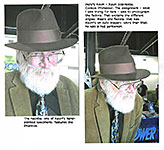 |
|||||||||||
Opus 422a (November 29, 2021): It’s “awards season,” and we list the National Cartoonists Society’s Reuben Division Award winners, the nominees for the Reuben itself, and the recipients of the EWK, Babin, Berryman awards. We also post a generous sampling of October’s editorial cartoons, celebrate leaf-peeping in Colorado, and say a fond farewell to Kevin Robinette, “Comics Professor.”) In order to assist you in wading through all this plethora, we’re listing Opus 422a's contents below so you can pick and choose which items you want to spend time on. An asterisk* marks the longest items. Here’s what’s here, by department, in order, beginning with the news of the day—:
NOUS R US NCS Celebrates 75th with Fund Raiser Four Nominees for Reuben *Reuben Division Award Winners Announced FCBD Returns to May In 2022 Telnaes Named EWK Laureate Matt Davies Gets the Babin Award Bolling Wins Berryman Award DC’s New Superman Is Bisexual Horsey’s Ostrich Inspires Protest George Washington Covers The New Yorker Afghanistan “War”
CARTOONS IN THE CANCEL CULTURE *Australian Michael Leunig Errs
FUNNYBOOKS FAN FARE Review of Eat the Rich No.1
Trumperies The Antics and Idiocies of Our POOO (Previous Occupant of the Oval Office)
**EDITOONERY The Mock in Democracy Over the Last Month Includes a Section on Gag Cartooning And—: Recent Election, Anti-Vaxxers, Biden’s Failures, Climate Change, January 6, Facebook Fate, Defaulting on National Debt, Colin Powell’s Death, Abortion, Bipartisanship, and More
BOOK MARQUEE Short Review Of—: EC Archives: Saddle Justice
PERSIFLAGE Leaf-peeping
PASSIN’ THROUGH Kevin G. Robinette, Professor Comics
QUOTE OF THE MONTH If Not of A Lifetime “Goddamn it, you’ve got to be kind.”—Kurt Vonnegut
Our Motto: It takes all kinds. Live and let live. Wear glasses if you need ’em. But it’s hard to live by this axiom in the Age of Tea Baggers, so we’ve added another motto: Seven days without comics makes one weak. (You can’t have too many mottos.)
And in the same spirit, here’s—: Chatter matters, so let’s keep talking about comics.
And our customary reminder: don’t forget to activate the “Bathroom Button” by clicking on the “print friendly version” so you can print off a copy of just this installment for reading later, at your leisure while enthroned. Without further adieu, then, here we go—:
NOUS R US Some of All the News That Gives Us Fits
NCS CELEBRATES 75TH ANNIVERSARY WITH A FUND-RAISER FOR CHILDREN The National Cartoonists Society and the NCS Foundation held an art auction online to raise money for St. Jude Children’s Research Hospital. The auction, celebrating NCS’s 75th anniversary year, was conducted by Heritage Auctions, the industry leader in the field of comic and cartoon artwork. The auction went live on October 27 and ended November 3 this year. Over 150 pieces of original art were up for bidding, including such favorites as Dennis the Menace, Wonder Woman, Captain America, Dumbo, MAD Magazine’s Spy vs Spy, Archie, 101 Dalmations, The Fantastic Four, Yogi Bear, Deadpool, Ren and Stimpy, Mutts, Zippy, Dick Tracy, and many more. Collectors bid on works by a star-studded array of the world’s greatest cartoonists, including Charlie Adlard, Sergio Aragonés, Jim Borgman, Dan Brereton, Howard Chaykin, Jim Davis, Eric Goldberg, Cathy Guisewite, Lynn Johnston, Jeff Keane, Rick Kirkman, Bobby London, Patrick McDonnell, Luke McGarry, Wiley Miller, Eric Powell, Stan Sakai, Mark Schultz, Jerry Scott, Scott Shaw!, Jill Thompson, Angelo Torres, Garry Trudeau, Mort Walker, and many other popular creators. All proceeds from the final bids will go to benefit St Jude Children’s Research Hospital. NCS president Jason Chatfield remarked “Cartoonists are blessed to have the ability to make people laugh or inform their opinions with our lines on paper. But we’re so much more fortunate to be able to give aid and comfort to kids in need through the sale of that original art.” The NCS bills itself as “the world’s largest and most prestigious organization of professional cartoonists.” It had its beginnings during World War II when groups of U.S. cartoonists got together to entertain soldiers recovering from wounds in New York area hospitals, and after the War, the cartoonists, whose profession is notoriously solitary, realized that they liked getting together and decided to continue to do so on a regular basis. Thus, in 1946, the NCS was born. (The details are supplied in Harv’s Hindsight for April 2010.) Today, the NCS membership roster includes over 500 of the world’s major cartoonists, working in many branches of the profession, including comic books, editorial cartoons, animation, webcomics and other online platforms, newspaper comic strips and panels, gag cartoons, greeting cards, advertising, magazine and book illustration and more. Membership is limited to established professional cartoonists, with a few exceptions of outstanding persons in affiliated fields.
NOMINEES FOR NCS REUBEN CARTOONIST OF THE YEAR With a special breathless Bunny Bonus a few weeks ago, we announced that Ray Billingsley, creator of the syndicated comic strip Curtis, had won this year’s Reuben as NCS’s Cartoonist of the Year, becoming the first Black cartoonist to be so honored. The award was presented during this year’s NCS convention October 16-17, a virtual gathering. Billingsley
was one of five nominees for the Reuben, and since being nominated is an honor
in and of itself, we’re listing the other four nominees herewith (text taken
from the NCS website)—: ◆ Bill Griffith is a pioneer of the underground “comix” movement. His career has spanned decades and he has left an indelible mark across the entire comics idiom — comic books, syndicated comic strips and graphic novels. His character, Zippy the Pinhead, is recognized worldwide and is celebrated as equally absurd and profound. With his graphic novels, Invisible Ink, Nobody’s Fool, and his forthcoming graphic biopic of Ernie Bushmiller, Griffith has continued to cement his place in the pantheon of comics greats. (See Harv’s Hindsight for July 2011 for more on Griffith.) ◆ Terri Libenson (pronounced LEE-ben-son) is a New York Times bestselling children’s book author and award-winning cartoonist of the syndicated daily comic strip, The Pajama Diaries, which ran from 2006-2020. The Pajama Diaries launched with King Features in 2006 and ran in hundreds of newspapers internationally until its retirement in January, 2020. Pajama Diaries has been nominated four times for the Reuben Division Award for “Best Newspaper Comic Strip” and won in 2016. ◆ Hilary Price’s comic strip, Rhymes With Orange has been a stand-out for more than 25 years. Drawing from her deep appreciation of classic magazine gag cartoons, comic strips, and picture books, Hilary has created something wholly original and forever made newspaper comic sections richer. ◆ Mark Tatulli is a comic strip writer/artist, animator and television producer, known for his comic strips Lio and Heart of the City (the latter, he retired from a year or so ago, leaving it to another cartoonist). Tatulli is also the author/illustrator of the middle-grade novel series, Desmond Pucket. Three books in the series were released: Desmond Pucket Makes Monster Magic (2013), Desmond Pucket and the Mountain Full of Monsters (2014/2015), and Desmond Pucket and the Cloverfield Junior High Carnival of Horrors (2016). Tatulli released a biographical graphic novel, Short and Skinny, in 2018. It chronicles a summer in middle school in which he was inspired by the original Star Wars to make his own parody of the film, while dealing with navigating relationships with bullies, friends, parents and body image. Price and Tatulli have been nominated for the Reuben before—Price several times.
I’VE CRITICIZED NCS REPEATEDLY over the years for its institutional blindness. Reuben nominees (and, hence, winners) are almost always syndicated cartoonists. And NCS has sinned again this year. It boasts itself as “the world’s largest and most prestigious organization of professional cartoonists,” and yet cartoonists who produce comicbooks, magazine gag cartoons, editorial cartoons, animation, book illustration, advertising, and greeting cards are mostly ignored in nominations for the Reuben award. NCS is notoriously slow in recognizing new venues for cartooning. Graphic novels and online comics have finally been added to the list of “Division” Awards, but it will doubtless be the next millennium before anyone working in those areas is nominated for a Reuben. Of the 76 Reuben winners (one year, it was a tie; hence, two Reuben winners that year) only 20 have worked in a medium other than syndicated newspaper comics or panel cartoons. Ronald Searle, Bill Mauldin, Sergio Aragones, Al Jaffee—these are among the 20 non-syndicated. The 20 include 4 editoonists and yet editorial cartooning has been alive and well for several decades before comic stripping started. And only 5 women have won a Reuben. So it is with a certain grim satisfaction that I note this year’s slate of Reuben nominees includes two women. It also includes Bill Griffith, who is a barely tamed underground cartooner. And that represents another step forward.
NCS ALSO CONFERS “DIVISION” AWARDS. Cartooning is divided into “divisions”— newspaper comic strips, magazine gag cartoons, editorial cartoons, and so on. The Division Awards have created a largely insurmountable problem for NCS. Until a few years ago, winners of Division Awards called them “Reubens” and said they were Reuben winners. But that wasn’t true. Only the Cartoonist of the Year gets a Reuben. All the rest—the Division Awards—do not include “Reuben” in their titles. But winners of Division Awards persisted: they were Reuben winners. To eliminate this problem, NCS decided to surrender to the inevitable. If winners of Division Awards said they were Reuben winners, so be it. These awards were suddenly dubbed Reuben Division Awards. That lasted about a year before it was overwhelmed with its own semantic confusions. Now, today—and this year’s “Division Awards”—we’re back with simply Division Awards. And if a Division Award winner wishes to cheat and call himself a Reuben Division Award winner, fine. Here, below, are listed this year’s Reuben Division Award winners—:
Newspaper Comic Strip: Ricardo Siri, aka Liniers – “Macanudo” Newspaper Panel: Mark Parisi – “Off the Mark” Editorial Cartoon: Bruce MacKinnon Gag Cartoon: Ellis Rosen Comic Book: Walter Simonson – “Ragnarok: The Breaking of Helheim” Graphic Novel: Jared Cullum – “Kodi” Book Illustration: Janee Trasler – “Frog Meets Dog,” “Goat in a Boat,” and “Hog on a Log” Magazine/Newspaper Illustration: Peter Kuper Advertising Illustration: Luke McGarry Online Comics – Long Form: Tom Siddell – “Gunnerkrigg Court” Online Comics – Short Form: Rosemary Mosco – “Bird and Moon” Greeting Cards: Scott Nickel Animation – Feature: Maria Pareja – Production Designer on “Wolfwalkers” Animation – Television: Genndy Tartakovsky – Creator/Director of “Primal” Animation – Online: Sammy Moore and Ewen Stenhouse of Golden Wolf Studios – Directors of “Brawl Stars: Barley’s Bar” and “Piper’s Sugar & Spice” video game promotional videos Variety Entertainment: John Graziano – “Ripley’s Believe it or Not!”
AS WE GET TOWARDS THE BOTTOM OF THE LIST (sorry: the “end” of the list), another of NCS’s problems emerges. There are simply too many awards given in obscure venues of cartooning. The first four awards at the top of the list is about what NCS began with when it started adding to the Cartoonist of the Year category. Then observant persons realized that there were cartoonists doing cartoons in places that these four categories didn’t cover. They were mostly newspaper venues; and there were other places where cartoonists worked, and their excellences should be recognized. Advertising, greeting cards, and illustration in books, magazines and newspapers and were added. And then the comic strip division was split into “humor” and “serious” for a short while; then they reverted to a single category. NCS finally admitted that comicbooks were drawn by cartoonists; ditto that soaring medium, graphic novels. New divisions again. Then came animation in all its manifestations. Too much. And there was another difficulty. I attended the NCS Reubens Weekend (convention) for several years, and I was disappointed to observe that many of the winners in various divisions—usually those not associated with newspapers—didn’t bother to show up to receive their awards. NCS was just giving awards to people who didn’t appreciate the grandeur of the National Cartoonists Society. They just didn’t give a damn.
I don’t recognize any of the cartoonists in the animation and online categories. I recognize Peter Kuper (a relative newcomer to editorial cartooning), Parisi (gag cartoonist), MacKinnon (a Canadian cartooner, whose work often strays across the border), and Walt Simonson. Simonson is a good comicbook cartoonist and certainly deserves the recognition; but he hasn’t been as visible as other comicbook artists, newcomers perhaps, who are working in bold new manners. Liniers’ comic strip Macanudo is a newcomer and a stunning one, exploiting the formal capacities of the medium for laughs. He is a brilliant choice to win in the Comic Strip Division.
In playing with the nature of his medium, Liniers resorts to a varied cast: the little girl Henrietta and her cat Fellini and her teddy bear Mandelbaukm; Martin and his imaginary monster Olga; witches named Gudrun and Huberta; and some penguins and gnomes with long stocking-cap headgear. Liniers and his strip are native to Argentina; “macanudo” means “cool.” Luke McGarry wins something almost every year. He’s one of NCS Past Prez Steve McGarry’s two sons, and I always suspect Steve of pulling strings behind the scenes to get Luke awarded something. I’m sure there are others in the advertising/illustration Division whose work is more attractive than McGarry’s wooden figures, but I can’t say who they might be. And if they’re in the same Division as McGarry, they’re probably not going to win. Sorry: I’m just kidding. (A great kidder, me.) Regardless, the NCS awards system is slowly dying off of some sort of inner rot. But the death throes will keep it functioning for a couple dozen more years, I’m sure.
FCBD RETURNS TO MAY The next Free Comic Book Day will take place on Saturday, May 7, 2022, returning to the tradition of holding it on the first Saturday in May, organizer Diamond Comic Distributors announced. The 2022 event will feature 45 free comics, 11 from Gold sponsors and 34 from Silver sponsors. That’s down from last year’s count of 55 comics: 12 Gold, 39 Silver, and four DC titles that were announced separately. Down by not by much. FCBD was postponed due to the pandemic in 2020, and rather than reschedule that year, the organizers decided to spread it out across a nine-week period, with different free comics released each week. That allowed retailers to promote the event while keeping their stores from getting too crowded, and publishers to release promo comics for summer and fall releases. Last year’s FCBD was held in August.
TELNAES NAMED EWK LAUREATE Ann Telnaes, who draws both still and animated editoons for the Washington Post, is this year’s winner of the EWK Prize. Named after political cartoonist Ewert Karlsson and presented each year by the EWK Society in Sweden, the award celebrates satirists and cartoonists around the globe. Telnaes is one of the most decorated cartoonists: she has previously won the Pulitzer Prize and the NCS Reuben Award. The selection jury noted that Telnaes’ work “appears as a ‘shining star of hope’ for picture-oriented journalism in a media landscape under pressure,” and that “her scathing visual comments, honed by her characteristic style, have been a force in the political game.” Telnaes is only the second woman ever to receive the Pulitzer, which has been awarded since 1922. How does she view the fact that so few female satirists have a voice in the public debate? “As in other professions, women have always been overlooked and undermined by the representatives of patriarchal ideology. But I feel optimism and hope for the young generation of female satirists who are now raising their voices and demanding their rightful place in the debate,” says Ann Telnaes. “I have had my eyes on Ann Telnaes since I first saw one of her satirical drawings about George W. Bush around 2010. She has a platform that few satirists enjoy, at a time when the genre often has to fight for its space. It is a great responsibility, which Telnaes shoulders masterfully,” says Carina Milde, curator at the Museum of Work and acting chairman of the EWK award jury. In a formal acceptance statement Telnaes said: “I am very honored to receive this distinguished prize and also grateful that the art of satire and visual commentary is recognized and valued. Editorial cartoonists and their work are an early barometer for the free speech health of societies and an essential part of democracies. The troubling increase of autocratic regimes and an intolerance towards freedom of expression shows that the work of my colleagues from around the world is more necessary than ever.”
Her work is distinguished by a barbed and often feminist perspective, springing upon an unsuspecting viewer a point that is wholly unanticipated in our sexist culture and reminding us thereby that humanity comes in at least two sexes. Her Taliban cartoon near here is an example. See also Opus 149. Due to COVID-19, the cartoonist will be unable to travel to Sweden to accept the award, and will instead be presented with the prize in San Francisco on Nov, 18, from Honorary Consul Barbro Osher.
MATT DAVIES GETS THE BABIN AWARD From D.D. Degg at dailycartoonist.com—: Newsday’s Matt Davies is the 2021 recipient of the “Rex Babin Memorial Award for Excellence in Local Cartooning.” The panel of judges also named Robert Ariail, David Horsey, and Marc Murphy as finalists. The award was announced online on Friday, October 8, during Zoomfest ’21, the virtual convention of the Association of American Editorial Cartoonists (AAEC). Pulitzer Prize-winning, Herblock Prize-winning, Robert F. Kennedy Journalism Award-winning, Headliners Award-winning editorial cartoonist Matt Davies adds another trophy to his shelf. Davies
has been the staff cartoonist for Newsday on Long Island since 2014, and
has drawn on New York politics for newspapers such as The Journal News and The Village Voice since the early 1990s. Davies’ cartoons are
syndicated through Andrews McMeel and appear in media outlets nationwide. “Devastating whimsy,” writes Rob Rogers, one of the three judges for the Babin Award. “That is the best way to describe Matt Davies’ impactful political cartoons, populated by funny-looking, rubbery, boneless characters. “It’s hard to beat Matt Davies,” added judge JD Crowe. “His funky, crosshatched characters are too much fun to watch, their messages too powerful to ignore. Davies doesn’t let up when he’s drawing about local issues. Corruption and nepotism in local police departments, the Long Island Railroad, power companies and school districts—they all get the full-fledged Matt Davies cartoonery Pulitzer power treatment.”
BOLLING WINS BERRYMAN AWARD Ruben Bolling, author of the Tom the Dancing Bug, a satirical weekly comic strip, has won the 2021 Clifford K. and James T. Berryman Award for Editorial Cartoons from the National Press Foundation, announcing the winner in a press release. The judges cited Bolling’s “mordant wit, superior artwork and inventive delivery.” The cartoonist parodies well-known American cultural memes, from Charles M. Schultz’s Peanuts to Richard Scarry’s children’s books to The Matrix.
His 2021 work included biting commentary on the U.S. response to the coronavirus pandemic, the January 6 attack on the Capitol, and the Q-ANON conspiracy theory. “I'm really honored,” said Bolling, “and I know I'm repeating myself, but I don't care: Anytime I'm given any honor I only want it to reflect on the people and entities who partner with and support me and Tom the Dancing Bug: “My web clients, BoingBoing.net, DailyKos.com, and GoComics.com, who have always shown great faith in the comic strip, and have brought it their great and incredibly enthusiastic audiences; “Andrews McMeel Syndication, who has been a valued partner and great friend for almost 25 (!) years, and all of Tom the Dancing Bug valued print clients; and “The Inner Hive, the team that every single week makes the very existence of Tom the Dancing Bug possible, and much more fun. “Anyway, my thanks to the National Press Foundation. I'm grateful to the judges for finding something worthy in my comics, and for finding that cartooning in general is worthy, apparently a view that is not universally shared among judges of cartooning awards. “So I appreciate the recognition, but I want to give a shout-out to my colleagues in the U.S. and all over the world, doing some of the most groundbreaking, innovative, brave cartooning in the history of the medium, in increasingly dark and difficult times! I'm proud to be with you!” Tim Campbell is the runner-up for the 2021 Berryman award for a hilarious and heartbreaking illustrated series based on comments the artist collected from middle school students during the pandemic. RCH: Bolling’s method, using the famous creations of other cartoonists as springboard to his own commentary, relies upon the creative genius of others for its success. While Bolling is clearly to be credited for the ingenuity of his technique, it is relatively easy to criticize Charlie Brown’s affection for capitalism by using a set piece from Peanuts —Lucy’s charge for consultation.
DC'S NEW SUPERMAN COMES OUT AS BISEXUAL The comic book industry has worked to increase LGBTQ+ representation in recent years, and DC is taking a major step forward in 2021 when the current Superman, Jon Kent, comes out as bisexual in the upcoming Superman: Son of Kal-El No.5 according to Jesse Schedeen at ign.com. The “current Superman” is the son of the traditional Superman, Clark Kent and Lois Lane, whom Kent married some few years ago. While Action Comics explores Clark Kent's adventures off-world, the recently
launched Superman: Son of Kal-El focuses on the 17-year-old Jon as he
grapples with the biggest responsibility of his young life. But at least he has
someone new to share that life with, namely Jay Nakamura, a hacktivist who
idolizes Jon's mother Lois and has already lent his new friend a helping hand. "Over the years in this industry, it probably won’t surprise you to hear I’ve had queer characters and storylines rejected. I felt like I was letting down people I loved every time this happened" writer Tom Taylor tells IGN. "But we are in a very different and much more welcome place today than we were ten, or even five years ago. When I was asked if I wanted to write a new Superman with a new No.1 for the DC Universe, I knew replacing Clark with another straight white savior could be a real opportunity missed. I’ve always said everyone needs heroes and everyone deserves to see themselves in their heroes. Today, Superman, the strongest superhero on the planet, is coming out. "Jay has his own fight," Taylor continued. "He’s obviously an effective journalist, and Lois Lane is his hero. But Jay is also a refugee from Gamorra, so his experience also reflects Clark’s. While this has fortunately changed over the years, historically, Lois has often fulfilled a damsel role. Jay Nakamura will never be that. He and Jon will tackle many things side-by-side." This also plays into another reveal coming up in Son of Kal-El. Jay himself has superhuman powers, making him both an invaluable ally to the new Superman and a companion for a young man who's never had much of a chance to build a life for himself in the regular world. Both Taylor and artist John Timms are well known for their work with Harley Quinn— Taylor in the pages of Injustice: Gods Among Us and Timms drawing numerous issues of Harley's monthly series. Given that Harley was probably DC's most high-profile LGBT character prior to this news, we were curious if their experience with the character has informed their work developing Jon and Jay's relationship. "Harley is a vastly different character than… any other character in comics," Taylor admits. "Jon and Jay are very different people. What I will say is Harley was the first character I was able to write as openly bisexual. Through our own universe of Injustice, we were able to tell stories and show relationships that maybe weren’t being depicted elsewhere at the time. And I was honored to have the chance to write the marriage of Harley and Poison Ivy last year in Injustice: Year Zero." "Relationships in Harley's love life are always a crazy ride," Timms says. "Still, the main lesson is to be as natural as possible, going with actions from within the characters, driven by emotions and letting them be. I hope to achieve the same with Jon and Jay; although it is always complicated to keep the stoic exterior of a superhero character combined with strong feelings that will not always be rage or pain, it is a welcome challenge." "The question for Jon (and for our creative team),” said Taylor, “is, what should a new Superman fight for today? Can a seventeen-year-old Superman battle giant robots while ignoring the climate crisis? Of course not. Can someone with super sight and super hearing ignore injustices beyond his borders? Can he ignore the plight of asylum seekers?" Taylor continues, "When asking these questions, it’s important to acknowledge that Jon isn’t just the son of Kal-El, he’s also the son of Lois Lane. Jon is the son of the fiercest, most effective journalist on the planet. With that, comes a strong sense of right and wrong, an instinctive dislike of corruption and a strong desire for the truth to win over misinformation. But Jon is young and passionate and sometimes how he tackles things will be a bit heavy-handed. And just like we see in our world, when young people speak truth to power, it ruffles the feathers of certain older people who are used to being the loudest voice in the room."
POLITICS IN THE CLASSROOM By Ben Crnic at the Journal Inquirer A political cartoon used in one of the questions on a seventh-grade social studies reading comprehension test at Tolland Middle School is at the center of a controversy on politics being inserted into the classroom. The nationally syndicated cartoon by David Horsey of the Los Angeles Times depicts a farmer tending his crops with an ostrich burying his head in the sand. The
farmer wonders if a drought is affecting his crops, and the ostrich, labeled as
the “Republican Party,” replies “Don’t even think about it. Global Warming is a
hoax!” The students in the class were then asked questions involving the interpretation of the cartoon, in which one of the correct answers was Republicans not believing global warming is real. “Politics shouldn’t be injected in class,” Town Councilman Lou Luba, a Republican running for re-election, said this week. Luba said that a Tolland resident with a child in the school brought the matter to the Town Council’s attention. The Republican council members then asked the school superintendent and the Board of Education to investigate the matter further. “There is a very obvious political slant and overtone in the question which makes it improper, regardless of party, and needlessly injects the teacher’s political bias into a graded assignment,” the emailed request from Republicans states. Superintendent Walter Willett defended the use of political cartoons in social studies classes, however. “By their nature, political cartoons are hyperbolic,” he said, adding, “social studies classes analyze visual depictions of information.” Willett also said the school encourages this kind of analysis so students can hone critical thinking skills, and do not immediately assume that the visual information they see is true. “I would hate to see the school weaponized against any group,” Willett said. Board of Education member Madhu Renduchintala, a Democrat who is not running for re-election, said that he appreciated the Town Council members bringing it to the attention of the school board, but thought the test itself wasn’t meant to oppose any one group. “I don’t believe there was any malicious intent behind this,” he said. Town Council Vice Chairman Steven Jones, a Democrat who is running for re-election, said, “I think anything that is kind of political will be especially sensitive now, especially in this political climate that is upset and hostile.” He added: “Maybe the cartoon isn’t the best example.” Republican Council members said they are also concerned that the resident who brought the matter to their attention wished to remain anonymous in fear of retaliation or retribution against their child and family by the teacher involved. “No parent or student should ever feel apprehension or fear of retaliation by a teacher or community members against their family. The fact that the parent and student were reluctant to even bring this issue up calls into question the tenor and atmosphere of Tolland Middle School and Tolland Public Schools, overall,” the email Republicans sent to the superintendent states. This was briefly addressed at Wednesday night’s Board of Education meeting when Republican member Anthony Holt said he wants to improve communication between the public and the school board, and make sure they don’t “hear things from Facebook.” Holt, who running for re-election to a four-year term, said Thursday that the Board of Education and Willett would review the cartoon and see if there are “other opportunities to get the information across.” He also said the school board would review how to best communicate with the public. Jones said parents with concerns should reach out to the Board of Education, and matters should be handled directly between parents and the administration to ensure that all parties involved are comfortable.
GEORGE WASHINGTON COVERS THE NEW YORKER Most of us
remember having seen at some moment in our lives Emanuel Leutze’s 1851 painting
“Washington Crossing the Francoise Mouly, The New Yorker’s art editor, talked to Blitt “about the particular pleasures and difficulties inherent in trying to catch the passing moment,” and we’ve quoted from that exchange hereafter.
Mouly: There are so many urgent issues facing the nation, from dealing with climate change to restoring voting rights. As a political cartoonist, this must present you with plenty of fodder. Blitt: Well, sure, I guess having all hell break loose is inspiring to political cartoonists, but I can’t help feeling that all hell’s been breaking loose pretty much all the time for a while now. It’s getting easy to become a little desensitized to it—or, at least, to look in other directions for funny stuff to draw. Mouly: You’ve riffed on this same painting, “Washington Crossing the Delaware,” before. What is it about the image that interests you? Blitt: One of my first attempts at a kind of commentary—when I was fresh out of art school—was an inane series of drawings of George Washington. This was strange, because I was still living in Canada and mostly drawing hockey players at the time. But something about stoic, over-the-top heroic archetypes has always made me laugh. The painting in question just seems to be crying out for a punch line. Mouly: For four years, you—and every other political cartoonist—had the Donald as a regular source of inspiration. Do you miss him? Blitt: I don’t miss him in any way, but he still rouses strong negative emotions in me. I worry that he’ll be back sucking the air out of the room before long. Believe me, I still have sketchbooks filled with unused ideas for Trump cartoons; if they never see the light of day, it’ll be all right with me.
AFGHANISTAN “WAR” We keep hearing that the Afghanistan War, 2001 - 2021, is America’s longest war. And yet neither of those situations is true. Whatever it was, it wasn’t “war” in the usual sense; and it wasn’t this country’s longest conflict either. The dates of the Vietnam War, 1955 - 1975, make it a war at least as long as the Afghanistan mess. But the Afghanistan War was not a 20-year war. It started in October 2001, so the year 2001 was scarcely a full year of war; and it ended in August 2021, only 8 months. In total, then, it was at best a 19-year war. But was it even a “war”? War is usually thought about in terms of combat, battlefield life-or-death encounters. Deaths, let’s say. America’s most deadly war was World War II with 291,000-plus dead. Second deadliest was the Civil War with 215,000 dead. Then Vietnam with 47,000, then the Korean War with 34,000. Afghanistan ended with 1,800 American dead. To repeat, the war of nearly equal length, Vietnam, caused 47,000-plus deaths. No comparison. At one time—when the U.S. first started sending combat troops to Afghanistan—it was in anticipation of a “war.” But that war never showed up. Meanwhile, the politicians who created the “war” kept calling it a “war” because, somehow, that justified our presence in Afghanistan. But there wasn’t much of a battlefield. Not much shooting or bombing. Not enough dead to call it a “war.” Those who keep calling Afghanistan a “war” do so because a “war” somehow explains why American military have been there in hostile circumstances for nearly 19 years. For some of the Afghanistan warriors, America’s “longest war” is long enough; we should get out. For others, the “war” isn’t really a “war” but something else, akin to, say, a “police action” that could go on a lot longer because it hasn’t, yet, established a peaceful society. We could stay there a whole lot longer without establishing a peaceful society. Afghanistan has never been peaceful. It has never been a society. At best, it is a geographic area in which warring tribes fight over tribal jurisdictions. And grow poppies. But there is no war there, long or short.
Fascinating Footnit. Much of the news retailed in the foregoing segment is culled from articles indexed at https://www.facebook.com/comicsresearchbibliography/, and eventually compiled into the Comics Research Bibliography, by Michael Rhode, who covers comic books, comic strips, animation, caricature, cartoons, bandes dessinees and related topics. It also provides links to numerous other sites that delve deeply into cartooning topics. For even more comics news, consult these three other sites: Mark Evanier’s povonline.com, Alan Gardner’s DailyCartoonist.com (now operated without Gardner by AndrewsMcMeel, D.D. Degg, editor); and Michael Cavna at voices.washingtonpost.com./comic-riffs . For delving into the history of our beloved medium, you can’t go wrong by visiting Allan Holtz’s strippersguide.blogspot.com, where Allan regularly posts rare findings from his forays into the vast reaches of newspaper microfilm files hither and yon.
FURTHER ADO People tend to hold stubbornly to the opinions they have. Confronting them with some contradictory facts will not usually change their minds. But telling them a story will.—According to filmmaker Ken Burns
CARTOONS IN THE CANCEL CULTURE An Essay by Binoy Kampmark, a Commonwealth Scholar at Selwyn College, Cambridge. On January 7, 2015, the staff of the French satirical magazine Charlie Hebdo found themselves facing a form of cancel culture before it became fashionable in the Twaddle sphere. It was of the most severe, lethal sort. Twelve people were butchered and the fanatic’s credo asserted. The assailants Chérif and Saïd Kouachi had been offended by the magazine’s cartoon depictions of the Prophet Muhammad. To add insult to grave injury, figures of various shades of political color not exactly disposed to free expression were suddenly claiming they stood with the slain, declaring themselves in solidarity to be “Je suis Charlie.” ... The commissars of cancel culture have also gone for cartoons and animations of late, though the reasoning has varied. The cartoonist’s history is filled with grotesque caricature: the blackface Bugs Bunny from 1953 who pretends to be a slave; the same character who ends up, in 1944, on a Pacific island filled with unsympathetically depicted Japanese figures. (That’s war propaganda for you.) In 1968, the studio pulled a series of Looney Tunes and Merrie Melodies cartoons in what came to be known as the “Censored Eleven” for reasons of offensiveness. In recent times, the creepy skunk Pepé Le Pew, accused of supposedly contributing to “rape culture”, has been given the excision treatment. Dr Suess, the pen name for Theodor Geisel, has received his share of retrospective punishment, with the foundation bearing his name withdrawing six books. Call it, suggests Philip Nel of Kansas State University, a “product recall.” “They’re not being banned. They’re not being cancelled. It’s just a decision to no longer sell them.”
THE GROUNDS FOR GENEROUSLY APPLYING AN ERASER to political cartoon satire is taking matters towards more treacherous ground. The satirist serves to poke fun and mock the staid, the orthodox, the petty. The intention of such work confronts the peddled narrative rather than marching in step with it. This month, October, Australia has made its own modest contribution to cartoon cancel culture by taking aim (the word is appropriate) at one of its favorite scrawling sons. Michael Leunig, a declared “national treasure,” was gently let down by the editor of The Age after sketching a cartoon seen to be a bit on the nose of vaccination policy, notably in Victoria. The
paper chose not to run the work, featuring a tank equipped with a needle as a
gun barrel pointing at the equivalent of the “Tank Man” figure made famous
during the Tiananmen Square massacre in 1989. As matters transpired, this
proved to be one cartoon too many. Was Leunig’s effort a bit much? Was it in keeping with Charlie Hebdo’s description of itself as the irresponsible newspaper (journal irresponsible) offering humor at times stupid and nasty (bête et méchant)? This was certainly so for the paper’s editor, Gay Alcorn, who told Leunig that his thinking was not “in line with public sentiment,” which is always a worrying rationale to cite in any context of satire. “I have pulled multiple cartoons by Leunig, almost entirely on the grounds that they expressed anti-vaccination sentiment.” She insisted that cartoonists could challenge readers “but I had a concern with cartoons perceived as anti-vaccination.” Leunig thought this a bit rich, an instance of “wokeism and humourlessness” run wild. “The Tiananmen Square image is often used in cartoons around the world as a Charlie Chaplin-like metaphor for overwhelming force meeting the innocent powerless individual. In my view, it is a fair enough issue to raise in the most locked-down city in the world”.
HIS CARTOONS ON THE SUBJECT of mandatory vaccination have previously riled audiences. When the Victorian government introduced a policy of not permitting unvaccinated children to attend childcare or kindergarten, Leunig took to his pen. At the time, his efforts worried Jo Alabaster, a science communicator and advocate who claimed it sent “the community a message of fear and mistrust, based on ideas that simply aren’t truthful. Science gives us the knowledge that vaccines are the safest and most effective way we can protect our children against vaccine preventable diseases.” The reaction to Leunig’s axing did not lack that fundamentalist delight from those who feel that some things are beyond debate. Then there was his age, his gender, his skin color, and, the resort of those with no argument, a perceived lack of talent. “76-year-old white male cartoonist axed after being shit at his job for the past 20 years,” one social media vulture tweeted with glee, demonstrating a deep understanding of the issues. The less than mature outlet Junkee suggested that Leunig should have simply stuck to drawing ducks. All this had the effect of not engaging the contentions that vaccination policies do pose. There will be those unable to take them for genuine medical reasons. There will be those left out in the digital divide given the mandatory use of vaccination passports for travel and for admission to workplaces or venues. Protests numbering in the thousands against vaccine mandates and health passports have taken place in Italy, France and Greece. A good number of those protesters can hardly be dismissed as inhabitants of the lunatic, conspiratorial fringe. The unvaccinated have become the convenient whipping boys and girls of public health politics, just as those who marched against lockdown rules were deemed irresponsible “covidiots” with nothing particularly valuable to say. Such dilemmas are the sort that deserve a satirist’s depiction. In 2013, in response to another flutter of rage, Leunig rued that, “Making jokes is about the most wrong and stupid thing a bemused, middle-aged, white heterosexual Anglo-Saxon sort of Celt Australian male can do these days.” Humor, he suggested, had to be taken off the menu. The Age has gone one step further in taking him off its editorial page altogether. At least they did not shoot him. Dr. Binoy Kampmark was a Commonwealth Scholar at Selwyn College, Cambridge. He lectures at RMIT University, Melbourne. Email: bkampmark@gmail.com
IRKS & CROTCHETS I can’t believe in a religion that chooses as its symbol an image of human suffering. I can’t believe in a God who would allow it, who would watch his son die, suffering, and do nothing to stop it.
FUNNYBOOK FAN FARE Four-color Frolics An admirable first issue must, above all else, contain such matter as will compel a reader to buy the second issue. At the same time, while provoking curiosity through mysteriousness, a good first issue must avoid being so mysterious as to be cryptic or incomprehensible. And, thirdly, it should introduce the title’s principals, preferably in a way that makes us care about them. Fourth, a first issue should include a complete “episode”—that is, something should happen, a crisis of some kind, which is resolved by the end of the issue, without, at the same time, detracting from the cliffhanger aspect of the effort that will compel us to buy the next issue. A completed episode displays decisive action or attitude, telling us that the book’s creators can manage their medium.
IN THE OPENING SEQUENCE in Sarah Gailey’s Eat the Rich No.1, we meet Joey who’s in a convertible driven by her rich-guy boyfriend Astor. They’re going to meet his family, and she’s muttering to herself about what a possibly bad idea that is. Then Astor stops the car in a spasm of fear: they expect to arrive at his family’s beach house in time for a party being held in honor of the retirement of one of the household staff, and Astor hasn’t told anyone in his family that he’s given up drinking. “I can’t do this,” he agonizes. Joey calms him down and they go on. The “beach house” is a monstrous mansion. They go in, and Joey is completely inhibited in the presence of the very rich even though Astor’s dad, Pip, introduces himself to her in a gesture of friendship. She escapes, briefly, to the beach, where she meets Petal, young Cartwright’s nanny. Joey volunteers to help out with the little boy if Petal needs a break, but Petal immediately corrects her: never volunteer to help the help, she says—she being one of “the help.” Later, Joey and Astor watch an old friend of his, Bumper, play standup comedian and perform at the party. Joey notices that every time Bumper makes a joke about someone in the crowd, that person leaves. Pip leaves, she notices. The last to go is the guest of honor, the groundskeeper. Intimidated once again by the crowd, Joey leaves and goes out to the beach again. There, she witnesses Pip stabbing the groundskeeper to death. Then the dead guy is dismembered as a crowd gathers for a barbecue. Pius
Bak draws the story for Sarah Gailey. Bak’s style is crisp and clip-art clean.
He solves the problem Gailey gives him of depicting crowds of people by
scattering close-ups through the pages—not, however, to the exclusion of
full-length people. Drawing pretty girls is always a problem: there’s only one
way to draw a pretty girl’s face, and after you’ve drawn one, what do you do
for the next one? Bak solves this problem by giving Joey extraordinarily bushy
eyebrows. Gailey’s storytelling rewards a second reading, during which, we learn things about the situation that might have escaped us the first time through. Astor is somewhat on edge the evening of the party because he is remembering his first party which was for his nanny. Now we can understand why: if the guest of honor is always killed, the murder of his nanny would be disturbing. Similarly, Bumper is upset at his assignment—in effect, playing comedian for the murder of the family’s groundskeeper. And Astor is sympathetic to Bumper’s dilemma. A couple of completed episodes expand our knowledge of Joey, and since she is, in effect, our “eyes” throughout the book, getting to know her advances the story nicely. Her meeting with Petal, for instance, shows us that she is thoughtful (volunteering to help with the kid). And through her eyes, we learn of the peculiarity that one doesn’t associate with “the help.” Given the groundskeeper’s fate, we understand why Joey and the rest of the non-staff should steer clear of the staff. But is the theme of the title cannibalism? We’ll have to wait for No.2 to find out.
QUOTES & MOTS Arizona is hardly the only place where attacks on the electoral process are under way: a well-funded national movement has been exploiting Trump’s claims of fraud in order to promote alterations to the way that ballots are cast and counted in forty-nine states, eighteen of which have passed new voting laws in the past six months. ... Although the Arizona audit may appear to be the product of local extremists, it has been fed by sophisticated, well-funded national organizations whose boards of directors include some of the country’s wealthiest and highest-profile conservatives. Dark-money organizations, sustained by undisclosed donors, have relentlessly promoted the myth that American elections are rife with fraud, and, according to leaked records of their internal deliberations, they have drafted, supported, and in some cases take credit for state laws that make it harder to vote. —Jane Mayer, “The Big Money Behind the Big Lie,” The New Yorker, August 9
The Antics and Idiocies of Our POOO (Previous Occupant of the Oval Office) The POOO is still, alas, around. Making news. And the so-called “news” media is, as previously in 2016, turning a Manhattan Playboy and Self-proclaimed Sex God with Weird Hair into an actual candidate. Not that he’s qualified, mind you; he’s not. Not even after occupying the White House for four years. But the “news” media, by giving the Trumpet air-time and front-page stories, is “creating him.” Where there was once nothing (or next to it), there is now, “something.” Not something desirable but something nonetheless. The “news” media is therefore playing right into his hands—making something of nothing. And I, by taking note of editorial cartoons about him, am also playing right into his hands. I should ignore the hell out of him, and he’d go away. Unfortunately for our side, he is too good a cartoon character, and so I give him air-time and coverage. Like all the rest of the “news” media. You’d think I’d have learned. You’d think I’d have learned. Guess not. But
then, neither have most editoonists, including Chris Britt, who takes
the comic strip format to demonstrate how the Trumpet is preparing his Return:
he’s reincarnating all his old and proven gimmicks for getting the attention of
the “news” media (and of such willing trolls as moi). Steve Sack deploys visual metaphors to show us the Trumpet State of So-called Mind in the next two editoons. In the first, the Trumpet is the little old wine-maker, turning sour grapes into an intoxicating beverage for the obedient Grandstanding Obstructionist Pachyderm, who hopes the audit of election returns in a few states will reinstate the POOO. But this attempt is proving fruitless: the irregularities in those states that prompts the Trumpet’s action are minor procedural matters (such as initiating new rules at the last minute) that do not change the results of the voting. In his next offering, Sack shows the Trumpet in mid-tandrum, blowing his stack when confronted by the results of the election. Given the hysteria of the POOO, a ranking general in the U.S. military has taken the precaution of cutting off the Trumpet’s red button connection to war-making machinery. And we are duly thankful.
EDITOONERY The Mock in Democracy OUR POLITICAL LIFE these days consists largely of politicians whose talent is in getting themselves elected and re-elected. They’re great on the campaign trail. They are not, however, great as lawmakers: they’re too timid, too worried about how voters will vote in the next election and not concerned at all about the future of the Republic or the welfare of its citizens. Lawmakers are a different sort of personality— a stronger, visionary sort— and none of our champions on the campaign trail are that personality. Instead, they grovel for votes. Into this milieu comes barging the so-called “news” media. Which is more concerned about attracting viewers than it is about finding and reporting the “news.” So it looks for sensational stories—like anything outrageous the Trumpet might do (which is almost anything he does)—and regales us with them from dawn to dusk. In short, “news” has become entertainment. (That happened years ago, I realize.) The “news” media also tried to make a revolution out of the elections held earlier this month. The Democrantz were supposed to lose both governor races in Virginia and New Jersey. But they didn’t. They lost only one. So that comes out fifty-fifty instead of wholesale loss and thereby ruins the news sensation story. The “news” media is now trying to explain how they were wrong. And since, as a historical matter, the off-year governor elections in those states customarily (10 out of 11 elections) elect the candidate of the party opposite that of the occupant of the White House, we must view even the narrow victory of the Democrant candidate (which wasn’t supposed to happen at all) as a much more significant political event than the loss of the other Democrant candidate (which was supposed to happen). As is our custom in this department of Rancid Raves, we try to show how editoons work as visual metaphors to make merciless comment on the antics of the politicians and others “in the news.” The expectation is that in clearly understanding the function of the visual metaphors, we enhance our appreciation of the editoonist’s art. To
that end, we’ve devoted most of the immediately ensuing analysis to the
election that the Democrantz failed to lose enough. Before we get to that,
however, we pause to appreciate the metaphorical work of Peter Kuper,
who, in four panels for The Nation’s OppArt Weekly, shows how the
climate change summit is failing in its objective: to get to the summit, the
delegates use transportation that spews atmospheric pollutants with every
passing mile. In the first of our election coverage, Rob Rogers explains how Glenn Youngkin became the first Republicon to win statewide office in a dozen years. He did it by running determinedly on a conservative platform, opposing a clean energy requirements, masks and vaccine mandates and vowing to ban “critical race theory” from schools “on day one” of his term. As a shadow Trumpet assures us, “racist dog whistles still work”—a visual metaphor that works two ways: it explains Youngkin, and it reinstates the Trumpet in the public eye. Voters sent a message to Democrantz, rejecting their woke liberalism and extremist agenda. As veteran Democrank political consultant James Carville said, “Some of these people need to go to a ‘woke’ detox center or something.” And Lisa Benson dramatized Carville’s insight with an image showing wokeness as a bubble that voters are about to pin-prick into oblivion. For John Cole, on the other hand, this year’s off-year election was simply a turn-off for voters. Nothing about it excited them. And in fact, voter turn-out was less than it is for on-year elections. And then Ted Rall at the lower left shows how the “infinitesimality” of this election—its near total insignificance—is blown out of proportion until it seemingly means something. But the “news” media’s preoccupation with the off-year antics notwithstanding, the big news of the past month was, still, the coronavirus plague and related matters—chiefly vaccination and mask-wearing. In
our next exhibit, Rick McKee starts us off by making the unvaxxed and
unmasked as silly looking as possible, as sure an indictment of those positions
as any. Next around the clock, Drew Sheneman resorts to comic strip
format and in five panels piles up the evidence that he uses to ridicule with
contradiction the anti-vaxxer in the sixth. For Mike Luckovich at the lower right, the anti-vaxxers are passengers on a sinking ship who are opposed to lifeboat mandates, an obviously untenable belief, considering the circumstances. Then Pat Byrnes engages in verbal parallelism to equate disbelief in Covid with disbelief in bullets, another untenable position. In
our next array of ’toons, Matt Wuerker attacks the anti-vaxxers on
another score: the unvaccinated are getting infected with the coronavirus more
than the vaccinated are, and so they take up hospital space and medical
resources that would otherwise be deployed in battling other diseases. Thus, in
Wukerker’s imagery, the unvaxxed impose an unfair burden on medical Andy Marlette wins my applause for finding a way to show that anti-vaxxers are horses’ asses if they resort to using unscientific methods to ward off infection. Then Steve Sack at the lower right changes the subject to voter suppression with an image that shows how Republicons expect to win elections in the future: the Democrant checkers pieces the GOPachyderm simply nails down, rendering them immovable and therefore useless. Chris Britt at the lower left uses the metaphor of a hanging to show that by eliminating voting rights, the Pachyderm intends to end democracy.
THE LATEST IN POLITICAL ENTERTAINMENT is that Joe Biden is failing as Prez. And I’m not so sure. In fact, since we must depend upon the “news” media for news about Biden—i.e., “entertainment” about Biden— I’m pretty sure he is NOT failing. The “failing part” is the entertainment news lately. And since the House “unexpectedly” passed one of his two Big Bills a couple weeks ago—despite all the “news” media could do to drum up a failure for the sake of a sensational newsstory—it appears Biden is not failing DESPITE the news media. Okay, Biden blundered with the Afghanistan withdrawal, but that was, surely, as much the military’s fault for failing to advise him better. But
Biden is apparently failing in enough enterprises that editoonists have no
difficulty in finding some to use in ridiculing him. In our next display, Mike
Lester, for instance, uses the visual metaphor of a tavern to demonstrate
Biden’s unsuccessful attempt to swear off oil. He may be giving up a reliance
on “domestic” oil, but he remains reliant upon oil from oil-rich Arab
countries. Biden’s nearly nondescript physiognomy makes him difficult to caricature, but Lester has found an excellent way to do it. Next around the clock, Dick Wright uses the imagery of a horse and would-be rider to demonstrate Biden’s failures, the horse representing a list of achievements Biden has not succeeded in mounting. Mike Luckovich uses the metaphor of a bed of hot coals (the Republicons) to show how difficult Biden’s agenda is to achieve—while, at the same time, holding aloft four spinning platters (Manchin, Sinema, and Centerist and Progressive wings of the Democrank Party). For Pat Bagley at the lower left, Biden is the Old Man and the Sea of Ernest Hemingway’s famed novel. The Old Man, you’ll recall, caught the big fish he’d been battling all day long, but as he towed his catch home, it was devoured by sharks and sea gulls until there was nothing left. Compromise, which Biden correctly recommends for legislative progress, lets the sharks and sea gulls have their way with the big fish. Will they destroy too much of it? Mitch
McConnell, while no longer controlling the Senate (and, therefore, the entire
government), continues to exercise undue influence on legislative affairs. Matt
Davies in our next visual aid shows how the McConnell Rule works: in
effect, it changes to suit McConnell’s current scheme, whatever it may be. Next, Dave Horsey conjures up James Bond to serve in a metaphor for the McConnell Effect. Bond, standing at the left, says: “You push the U.S. economy to the brink of disaster, then you put it off until December. What is your goal, Senator McConnell, other than chaos?” To which McConnell, sipping Kentucky bourbon and smoking a cigar, responds: “What better goal is there, Mr. Bond?” Indeed. McConnell has never introduced legislation. He does nothing but obstruct. Consequently, he is, these days, the perfect Republicon. At the lower right in two panels, Matt Wuerker contemplates the contradiction inherent in Senator Joe Manchin’s opposition to “entitlement.” Ostensibly, he believes that certain government programs (the social ones in Biden’s agenda) foster an “entitlement mentality” which has the potential of undermining traditional American self-sufficiency. But he has no objection to Big Coal’s sense of entitlement when it comes to exploiting the environment for profit. Want to know why Manchin opposes any attempt to reduce our dependency upon fossil fuels? It’s the coal industry of his West Virginia home state that makes the biggest contribution to his election campaigns. Then Walt Handelsman demonstrates the consequences of following Manchin’s mandate: removing all that “crazy climate stuff” in Biden’s spending plan will produce a disastrous climate change with rising sea levels overwhelming coastal communities. The
threat of climate change continues to preoccupy editoonists in our next array. Dave
Horsey shows how his image of burning climate change roasting the Earth
trivializes the preoccupations of politicians, who, instead of addressing the
dawning disaster of a warming climate, prefer to whip up citizen excitement
over the Trumpet losing the election and cancel culture not to mention the
filibuster as a way of life. Next around the clock, John Darkow’s imagery invokes the Almighty Himself, who wonders why us human beings can’t see the signs of global warming that He has so generously distributed. The connection between the dying off of various species of plant and animal life and the dying off of human beings has not been made abundantly clear. Yet. But it is there. If insects die off, then the creatures that live on insects will die off; and eventually, it’s cows (beef) and vegetables that die off. And after that, us. Steve Sack makes the connection here (although perhaps not as clear as it could be made). And Joe Heller takes a step in the same direction. He could have carried it further with a couple more panels—ones that show how we can’t build houses if the forests die off and deprive us of lumber. But this’ll get us started in the right direction. In
our next exhibit, we contemplate elections and the Trumpet’s influence on the
Republicons. Dave Horsey retires to the neighborhood bar to ponder the
California recall, with the MAGA guy offering his wisdom—which is also in all
probability the Trumpet’s explanation for stolen elections. Then Steve
Breen’s imagery perfectly describes the relationship between the Trumpet
and the Republicon Party. John Cole turns our attention to the supposed “election fraud” being committed in various Republicon states. With this circular image before us, we can see exactly who causes the mischief in our elections. And then Marshall Ramsey offers a visual metaphor that ridicules the U.S. Postal Service’s proposed slackening of service. A bottle with a message inside cast upon the waters would be faster delivery. And now, in order to foster a moment of relaxation amid our contemplation of serious political and societal issues, we’ll take a short break such as is afforded by a few gag cartoons that promote laughter rather than frustration.
GAG CARTOONS
are most useful—apart from making us laugh—for demonstrating vividly the
verbal-visual nature of the medium. Usually, the picture makes little or no
comedic sense without the caption; we contemplate the picture as if it were a
puzzle—and the solution to the puzzle, the explanation of it is found in the
words beneath the picture. In the second cartoon in our first visual aid, the picture shows a pumpkin in a chair in what appears to be a doctor’s office. That guess is confirmed when we read the caption and listen to the doctor explain the procedure by which the pumpkin will be converted to a jack-o-lantern. Sometimes, however, the comedy in a gag cartoon is all visual—as in the first cartoon we see here. And
sometimes, the joke is entirely verbal—as with the three cartoons across the
bottom: The cartoons in the next display are all better cartoons: none of the pictures made sense without the captions. And the reverse is also true: none of the captions are at all funny without the accompanying pictures. And now, back to work in studying the editoonist’s use of imagery to make his comment on the passing political scene.
THE JANUARY 6TH INSURRECTION is next to be examined, starting with Rob Rogers, who, in
two panels, compares two American disasters: the 9Eleven attack on the World
Trade Center in New York and the January6th attack on the Congress in
Washington. The difference which the comparison enhances is in the Pachyderm’s
eagerness to forget the latter. Jeff Danziger shows the insurrection in full throttle, the mob apparently being egged on by the Pachyderm, who, with a typical Republicon attitude, takes no responsibility for his actions, instead, blaming it all on the most conspicuous Democrank in Congress. Clay Bennett’s metaphor is that of a criminal investigator dusting for the fingerprints of the guilty party, the inciting personage—and finding, in the fingerprint, the image of the perpetrator, the Trumpet himself. And then Pat Byrnes’ image is that of the happy Mitch meeting with his Pachyderm associates to plan the overthrow of the government, which, as the paper in the hand of one of the elephants tells us, can be efficiently achieved by failing to raise the debt limit. America’s
disastrous departure from Afghanistan attracts the attention of Clay Bennett in the next exhibit. The United States, safely in the embrace of its
parachute, will have a much less destructive landing than the airplane, which
Bennett shows descending rapidly, billowing smoke from its engines. The fate of Facebook is the topic of the next three editoons. Nick Anderson’s visual metaphor of Facebook is a cigarette lighter about to set fire to some sticks of dynamite, each of which is labeled with the sort of misinformation Facebook is so adept at fostering—hate, violence, etc. Chris Britt continues in somewhat the same mode, but his metaphor is a gallows staffed by the various instruments of “hate”—MAGA enthusiasts, hooded KKK, Nazis, Zukerberg himself and so on—all lining up next to the hangman’s noose. And Jeff Stahler resurrects a once-familiar chant from Walt Kelly’s comic strip, Pogo, depicting Pogo himself, reading Facebook on his device, which tells him that “we have met the enemy and he is us.” Our
next array begins with two editoons focused on defaulting on the debt ceiling.
In Nick Anderson’s image, “defaulting” is the time bomb that’s soon to
explode; tied to the bomb as its victims are some ordinary citizens and the
Democrank donkey—plus the GOPachyderm and Mitch. Everybody will get blown up!
But Mitch, who engineered this dawning disaster, seems oblivious to its
consquences: he is looking forward to seeing the Democranks blow up, a perfect
metaphor for Mitch’s motivation. Walt Handelsman offers a different visual metaphor for failure to raise the debt ceiling. If we maintained our homes like Congress deals with the debt, we’d be surrounded by buckets to catch the leaks through the ceiling. The death of an American patriot on October 18 prompted several visual tributes. Colin Powell rose from humble roots as the Bronx-born, working-class son of Jamaican immigrants and a graduate of the tuition-free City University of New York. Powell found his calling there as a member of the Army Reserve Officer Training Corps and went on to a career in the military that ended when he reached the four-star pinnacle of power in that organization as chairman of the Joint Chiefs of Staff—and then went on to become the first Black Secretary of State. Jack Ohman recognizes Powell’s heroic stature in three panels that cover the culmination of his career as “the last sensible Republican.” Other editoon tributes simply pictured Powell and quoted him. Dave Whamond’s Powell (not pictured here) is saying: “A dream doesn’t become reality through magic. It takes sweat, determination and hard work.” Dave Horsey goes to greater lengths in quoting the General: “We have to start thinking of America as a family. We have to stop screeching at each other, stop hurting each other, and instead start caring for, sacrificing for and sharing with each other ... We cannot move forward if cynics and critics swoop down and pick apart anything that goes wrong to a point where we lose sight of what is right, decent and uniquely good about America.” At the lower left, though, Michael Egan sought to belittle Powell by reminding us of the single stain upon the General’s record. As Secretary of State, Powell called on the world to invade Iraq based on faulty intelligence about weapons of mass destruction. Egan calls “faulty intelligence” a “lie.” And it was, but it wasn’t Powell that told it. After examining lots of investigative reports, Powell decided that the intelligence community had it right—that Saddam Hussein was, indeed, compiling weapons of mass destruction and had to be stopped. In other words, Powell bought the lie. But I say he was more victim than perpetrator of the lie. What human being, no matter how many stars on his shoulders, would have the wherewithal to contest the accumulated “wisdom” of the American intelligence community once it’s made up its mind to use information to urge the world into war in Iraq. Not even Powell. And so I excuse him his blunder: the most that it did was to proclaim the modern hero a human being too.
ABORTION IN
TEXAS IS NEXT, and Tom Tomorrow (aka Dan Perkins) marches Texas Governor
Greg Abbot out to explain how the state’s new law is just fine. The comedy, as
almost always in This Modern World, arises from draping the speaker’s
remarks with heavy sarcasm. But if Perkins’ humor is extreme, that of Kevin
“Kal” Kalaugher next around the clock goes Perkins several decibels more in
both extremity and hysterical comedy. The image vividly reminds us about the
most efficient way to rid ourselves of unwanted pregnancies. Then Steve Greenberg constructs an image of the obstacle course of “vigilante-based” restrictions that a woman must successfully run in order to get to an abortion. In
the next exhibit, Clay Bennett’s image suggests that in Congress, which
occupies a building somewhat like that being depicted, bipartisanship is not
likely to be achieved because one wing of the government severely outnumbers
the other—so why should it compromise? Then Dave Horsey offers the next delicious image—just exactly the way we’ve always imagined a filibuster looks, fat and sloppy. Horsey also makes it clear that this bulky bulwark is interfering with legislative progress: it’s sitting on important bills—on voting rights, on debt ceiling, etc.—which don’t move as long as the fat man sits on them. But
it isn’t just the lack of bipartisanship that is holding up progress on Biden’s
legislative agenda. As Kevin “Kal” Kalaugher shows with his image of a
race car with too many drivers in the next array, the Democranks are quarreling
among themselves about what kind of a law they want to pass. But after weeks of will-we or won’t-we, Biden prevails after all, and Jeff Koterba imagines how he did it with an image of one of those big wheel trucks that climbs over everything, including every objection that had been raised. Nick Anderson changes the subject abruptly with metaphors for active shooter training in Texas schools as compared to the absence of training for either open or concealed carry in the Lone Star state. The philosophical contradiction implied in the two situations is happily ignored by the gun-toting Texan in the second panel.
OUR NEXT
DISPLAY is of editoons by Omaha native David Hitch, whose mastery of
black-and-white cartooning is stunning. Alas, because of the extravagance of his caricatures, my interpretation of Hitch’s message depends entirely upon what his nuanced visages are saying. An award-winning editoonist, David M. Hitch has been a conservative voice for the Omaha World-Herald, The Worcester Telegram & Gazette, and The Worcester Sun in a cartooning career that has persisted for more than three decades. As a junior in high school in Omaha, Nebraska, Hitch won the prestigious Hallmark Nomination, along with a Scholastics National Gold Medal in Art, and also won recognition for his work in political cartooning, architectural design and writing. While in college at The University of Nebraska at Omaha, and beyond, he was honored with The National Newspaper Association's “Best Original Cartoon” Award, as well as several Sigma Delta Chi and New England Associated Press Awards for illustration and editorial cartooning. The National Newspaper Association presented him with its Best Original Cartoon Award in 1987, and in 1989 he won an award for illustration in the New England Associated Press News Executives Association Page Presentation Contest. He also founded a commercial art studio in 1986. In 1988 he self-syndicated a weekly editorial cartoon feature, Stating Opinions, to a dozen Nebraska newspapers. His work suddenly cropped up on one of my editoon feeds, and I’ve been unable to resist posting at least one of his cartoons in every edition of Rants & Raves since. Even when I can’t tell who is speaking his messages.
WITH THE KNOWN
WORLD awaiting with bated breath the Supremes’ decision on abortion, the role
in making that decision that falls to the newest member of the Court is
conspicuous, and Signe Wilkinson’s visual metaphor prepares us for the
inevitable as we can tell from her editoon at the upper left of our ensuing
array. Next around the clock, Pat Byrnes’ imagery offers a look at a new breed of memorial statuary that has appeared where once statues of famous men stood. And below that, Adam Zyglis’s metaphor makes it clear that removing the statues doesn’t remove the bigotry that is their roots. Next Chris Britt’s imagery makes clear that Big Oil is happy with the California situation that permits off-shore drilling. The
next exhibit begins with one of Jeff Stahler’s talking couples. Many
(and, judging from what I see, all) of his editoons make their arguments by
having a man and a woman talking about some issue. In short, Stahler no longer
deals in metaphorical messages: his messages are contained in the verbal
discourse he letters on the page. The point at hand is that the woman has given
over her moral decision-making to Facebook. Walt Handelsman is another of the editooning fellowship that often resorts to depicting a couple’s conversation as a way of making his point—here, that inflation is taking a toll everywhere. Then Kevin “Kal” Kalaugher’s image of national “debt” as an obese devil whose pitchfork has pinioned the United States shows that both Democranks and Republicons are alarmed by the same nightmare. And for a happy conclusion to this display, we have an anniversary birthday wish from Bill Day for Disney World, an entertainment resort complex in Florida near the cities of Orlando and Kissimmee. Opened on October 1, 1971, the resort covers nearly 25,000 acres, of which half has been used. The resort comprises four theme parks, two water parks, 27 themed resort hotels, nine non-Disney hotels, several golf courses, a camping resort, and other entertainment venues, including the outdoor shopping center Disney Springs. The only bad thing about this, the second of Disney’s theme parks, is the cost of entry—now in the hundreds of dollars. But it’s Day’s silhouetting Mickey Mouse’s head-shape as the zero in 50 that makes this editoon visually appealing and therefore effective.
IN THE NEXT
EXHIBIT, Matt Wuerker creates an image suggesting that the polarization
in the U.S. at the present does as much damage to the country as if it were
invaded and conquered by the Taliban. Then Joe Heller gets a chuckle out
of an image showing Jeff Bezos contemplating a purchase of planetary
dimensions. Next Dave Granlund shows the news networks in hot pursuit of the latest “non-news,” the pursuit of which undermines the “news” media’s claim to a constitutional role in a democracy of keeping the citizenry informed. This criticism (often accompanied by pictures like Granlund’s here) is not new. In fact, it is as old as news media. And then John Darkow invokes the news of forest fires in the West, particularly in California where the giant sequoia forests are threatened, to ridicule the conservation pretense claimed by authorities but denied by their inaction. The next array begins with Tom Stiglich depicting some immigrants puzzled by the absence of Kamala Harris, whose assignment to the border problems suggests she ought to be nearby to assist them in gaining entrance to the country. But she isn’t. I suspect that Harris is actually doing something, albeit behind the scenes, on various issues, but the Democrank machinery is ignoring her for no good reason that I can see, and that leads to cartoons like this that publicly ridicule her non-function in the Biden administration. Or
maybe she is actually doing nothing. Next in two panels, Nick Anderson shows the Grandstanding Obstructionist Pachyderm up to his usual trickery—stopping everything. He sides with the fanatics who want to ban “critical race theory” (i.e., study of actual history) from the classroom—an act of educational sabotage that is the equivalent of burning books to destroy the source of knowledge. I don’t know if Clay Jones in the next cartoon is ridiculing some specific Republicon crowd action or if he’s just portraying the Pachyderm en mass as something in general to be feared. I suspect the latter, which justifies portraying people stampeding in fear at the lower left corner of this display. Then Andy Marlette is back with an impossible question. I suppose if our educational system must present opposing views, then that eliminates the Bible as something we should be teaching. What’s the opposing view? Nice question. Makes you ponder and applaud the wisdom of the writers of the Constitution in separating Church and State. Finally,
in our last exhibit, we begin with two editoons that achieve their effects by
sequencing thought processes. In the first at the top of the page, Tony
Murphy uses the first three panels to indicate the subject being pondered.
Then in the last panel, he gives Maggie the best lines. Her belief in what she
says in the last panel is a telling insight into ignorance about racism in
America—in effect, a ringing endorsement of “critical race theory” that seeks
to eliminate ignorance of Maggie’s sort. And then Loren Fishman in the comic strip Mallard Fillmore builds a wholly verbal case for thinking that the utterances of politicians are just farts across the political landscape. Not a bad idea. Except that it is achieved entirely by verbal means, just as Murphy’s attack on ignorance and positions of the talking couples of Stahler and Handelsman are achieved. I may love what they say, but their work is not political cartooning. It’s not cartooning of any kind because it does not blend words and pictures to achieve something neither alone without the other can achieve. Nick Anderson’s 4-panel editoon shows one way words and pictures combine for effect. The first three panels show the typical conservative (Republicon) attitude about gun control, Obamacare and unemployment insurance—all branded “socialism.” And therefore to be opposed and hated. But the tv message in the last panel opposes something our MAGA man is likely to support—making the rich pay more taxes. And in his response, the MAGA man is pictured as stopped in mid-protest, and he simply sputters. The picture is a response to the words, and together words and picture reveal the knee-jerk non-thinking political theory under which the MAGA man usually operates. And Rick McKee’s picture of the Trumpet contemplating a calendar of September and realizing that he won’t be reinstated in August is another example of words and pictures functioning together to make a point neither does alone. The Trumpet’s words reveal the simple-mindedness of his politics; the picture demonstrates what stimulates his verbal response. Together, they reveal the Trumpet for the unthinking knee-jerk political fake that he is. And that’s enough for the nonce. Onward to other matters of shaking import—:
READ & RELISH Here at the Intergalactic Rancid Raves Wurlitzer. Let us have wine and women, mirth and laughter, Sermons and soda water the day after.—George Gordon, Lord Byron
When I hear a guy lost a battle to cancer, that really did bother me. I’m pretty sure, I’m not a doctor, but I’m pretty sure if you die, the cancer dies at the same time. That’s not a loss. That’s a draw. —Norm Macdonald
BOOK MARQUEE Short Reviews and Proclamations of Coming Attractions This department works like a visit to the bookstore. When you browse in a bookstore, you don’t critique books. You don’t even read books: you pick up one, riffle its pages, and stop here and there to look at whatever has momentarily attracted your eye. You may read the first page or glance through the table of contents. And that’s about what you’ll see here, beginning with—:
The EC Archives: Saddle Justice Collection Editor Daniel Chabon; Original Series Editor William C. Gaines 208 8x11-inch pages, color; 2021 Dark Horse Books hardcover, $49.99 SIX ISSUES of this title, Nos.3-8, offer 31 stories, many by celebrated EC artists— Al Feldstein, who did 4; Graham Ingles, 9; and Johnny Craig, 3. The table of contents identifies, where known, the artist and writer of each story. Grant Geissman supplies an Introduction; Eric Red, a Foreword. Most of the stories are about outlaws, all of whom meet “justice” at the end. I was surprised at how much gunplay there is. Many of the stories are about women outlaws, and several of the stories are about historic figures—Belle Starr, Billy the Kid, Bill Tilghman. Apparently original artwork supplies the visual content (on page 111, a footnote tells us that original art for four pages has been lost so comic book pages were photographed instead); the color has been fully remastered digitally. The reprinting is apparently complete: text stories as well as advertising pages, including house ads, are here. And it’s all printed on glossy paper, which gives the entire production a garish shine. In No.5, EC publishes a short biography of Craig; in future EC titles, biographies of the artists are a continuing feature, unique to EC books. There are nits enough to pick. Geissman’s Introduction is about EC, but he manages a history of the company (which he’s done before) without citing very many dates. And Red’s Foreword, which is intended as a celebration of the Western, is, instead, an advertisement for his work in movies and Western novels. The Billy the Kid story (drawn by Johnny Craig) is about Sheriff Pat Garrett, who kills the Kid. Before recording that event, the story records a hostile encounter between the two when, in fact, they were friendly acquaintances. The Tilghman in the story about him is an outlaw; the real Tilghman was a lawman. And Belle Starr wears a big-brim cowboy hat that sports a giant feather! Stylish but wholly inappropriate, a historic anomaly.
This book is undoubtedly Dark Horse’s attempt to cash in on what has been for other publishers a lucrative publishing project—reprinting EC Comics. But the EC Comics that have inspired a dedicated fan following were those that hit the newsstands in the early 1950s; and these issues of Saddle Justice were published between May 1948 and October 1949 before EC, under the leadership of Gaines, began printing the high quality comics that made the company a legend in the industry. And this Western title was, in comparison, badly written and poorly drawn (if you’re going to draw a Western comicbook, you better be able to draw a man astride a horse). And that, perhaps, is its signal contribution to the history of comicbooks: it is a vivid demonstration of just how bad the funnybooks were in the 1940s—even EC before the fifties.
TICS & TROPES It’s hard to be a diamond in a rhinestone world.—Dolly Parton We shall sooner have the fowl by hatching the egg than by smashing it.—Abraham Lincoln What makes a nation great is not primarily its great men but the stature of its innumerable mediocre ones.—Philosopher Jose Ortega y Gasset Hesitation is a crucial element of creation. If people would rephrase writers’ block as hesitation, writers would feel better about it.—Ian McEwen
PERSIFLAGE & BADINAGE It’s leaf-peeping time in Colorado. Every year, during the last week or so of September, the aspen leaves turn from light green to bright yellow. And because the aspen are scattered in golden clumps across mountainsides amid rolling masses of pine tree velvet green, the colors alone are spectacular. Add the majesty of soaring mountain landscape, and it’s an experience worth having—year after year after year. The only question one asks at the appropriate time of year is: when do we go on a leaf-peeping jaunt? The third week in September? Or the fourth week? I’ve usually opted for the fourth week, but this year I’d heard that the aspen were going to turn early (because of the rain in August?), so we went up on Monday the 20th. No good. Very few aspen had turned, so we turned around and came home and laid plans to make the trek again the following Monday. And we did. Alas, while the views were engaging, they’d been better a couple days earlier; by the time we got there, many of the leaves had fallen, leaving bare aspen trunks standing naked in the woods. It wasn’t a complete failure—as I hope you can tell from the accompanying gallery of aspen-pix taken just a couple days ago. But it could have been better had I saddled up on Friday, say, to make the jaunt. Oh, well. There’s always next year. Meanwhile, feast your eyes on the attachments.
BADINAGE & BAGATELLES Letter to the Editor, the Denver Post—: In America we have the freedom to: Not get a vaccine so we can infect others with a deadly disease that has killed over 5 million people. Buy a military style weapon and kill many innocent people as fast as we can pull the trigger. Make a woman keep her pregnancy, even if it’s caused by a brutal rape or incest, because she can’t afford to choose for herself. Ignore global warming that creates catastrophic weather and serious climate calamities. Pollute oceans with plastic that threatens the lives of aquatic animals and plants. Burden future generations with huge amounts of public debt that will cripple their future approaching $100,000/person. Is it any wonder why babies cry so much? Fill the airwaves with vicious propaganda, false and deceptive information. Freedom is not really freedom when it inflicts on the freedoms of others. —Max I. Miller
ONWARD, THE SPREADING PUNDITRY The Thing of It Is ... VOTING RIGHTS THREATENED, CRT AND WOKE PROGRESS From the Southern Poverty Law Center—: Between January 1 and July 14, 2021, at least 18 states enacted 30 laws restricting voting access, according to the Brennan Center for Justice, quoted the SPLC Report, Fall, 2021. It reports that these “make mail voting and early voting more difficult, impose harsher voter ID requirements, make faulty voter purges more likely, among other things.” More than 400 bills restricting voting access have been introduced in 49 states during the 2021 legislative sessions. In George, new laws ban volunteers from providing water and food to people waiting in line to vote, a common occurrence at precincts with a large population of voters of color.
THEN THERE’S CRT. The recent attempts to censor what educators can teach about race and racism threaten students’ right to high -quality education. We must sound the alarm that this is a strategy fueled by white supremacy ideology. Lawmakers in several states are already moving legislatively. Alabama is considering a law that requires a teacher be fired if caught teaching “certain concepts regarding race or sex, such as critical race theory” in K-12 schools and “public institutions of higher learning. In Florida and Georgia, state boards of education have already passed resolutions banning classroom discussions of critical race theory. [The next three paragraphs are mine.—RCH] “Certain concepts” are those that strenuously imply that racism has shaped U.S. society and laws more continuously than is generally acknowledged. A tenet of CRT is that racism and disparate racial outcomes are the result of complex, changing, and often subtle social and institutional dynamics, rather than explicit and intentional prejudices of individuals. The Republicons, as might be expected, oppose CRT and are actively spreading lies about what it is. It is NOT a way of teaching grade school kids to hate their country (as is sometimes maintained). Lawmakers in more than 20 states have introduced or passed legislation that would directly target the principles underlying critical race theory by banning schools from teaching about structural racism (i.e., racism built inadvertently into the very structure of society). Now back to SPLC—:
BUT SOME PROGRESS HAS BEEN MADE. In the past six years, more than 300 Confederate symbols have been removed from public places, including 170 monuments. New data from the SPLC shows that more than 1,895 Confederate symbols are still publicly present in the U.S.; 692 of those symbols are monuments, many of them prominently located at county courthouses and town squares. That number also includes government buildings, schools, parks counties, cities, military bases and streets and highways named after Confederate figures. In updating its records, SPLC changed the designation of 32 memorials previously listed as removed because the pedestals were left in place and have words of symbols memorializing the Confederacy. In future, monuments will be listed as removed only if the pedestals have also been removed.
ACTOR LEADS POLITICIANS IN TEXAS POLL. Beto O’Rourke, who has been considering a possible run for Greg Abbott’s current seat without revealing any plans yet, recently commented on the also potential run of Texan actor Matthew McConaughey in Reform Austin. The actor, who has never clearly stated his political beliefs or defined himself as a Democrat or Republican, has appeared higher than Abbott in recent polls. O’Rourke suggests that McConaughey’s high popularity in the polls could be a consequence of the political ambiguity with which he has conducted himself so far. “He’s a really popular figure whose political views have not in any way been fixed,” O’Rourke said. “I don’t know, for example, who he voted for in the most consequential election since 1864 in this country. I don’t know how he feels about any of the issues that we’ve brought up. … So I think that might explain part of [the polling].” —Source, the Web (I forgot where, exactly)
WE’RE ALL BROTHERS, AND WE’RE ONLY PASSIN’ THROUGH Sometimes happy, sometimes blue, But I’m so glad I ran into you--- Tell the people that you saw me, passin’ through
PROFESSOR COMICS DIED I met Kevin Robinette several years ago at one of the first Denver Comic-Cons. He was making a presentation on some historical aspect of comics, and I went to see what he had to say. After his presentation, I offered a minor (terribly minor) correction to something he’d said. He had better manners than I: he didn’t agree with me but invited me to attend his bi-weekly meetings of comics fans. I
started the next week and continued, every other meeting or so, for the next
couple years. The GROUP (Greater Rockies Organization of Ultimate
Panelologists—Kevin’s buzz phrase) met every other Friday at a local northside
Denver bar/restaurant, where we had staked out a large-ish table in an obscure
corner. We’d occupy the table for the whole evening, drinking a little as we
went along, looking at comics, talking about comics, and, finally, having
dinner. Maybe 14 of us. These meetings were notoriously informal: the idea was that everyone would bring a couple or more comics or comics-related items and we’d pass them around the table and look at them. Kevin always brought more stuff than anyone else—whole suitcases full of it. And he’d pass all his “discoveries” around the table. Some new stuff; some wonderfully old stuff. In addition to these informal gatherings, Kevin taught a course in comics at an institution in San Francisco (the Academy of Art University, mentioned below). It was a one-meeting-a-week course, and, remarkably—as a measure of that institution’s regard for Kevin and his scholarship in comics— the institution paid Kevin’s weekly round-trip air-fare to San Francisco and overnight lodging there so he could meet with his class every week. Here’s Kevin’s elucidation: “I wrote and now teach the History of Comics with several on-site and on-line classes each semester. I cover over 100 years of comic characters from the newspaper strips and from the monthly comic books throughout each decade during the class.” The coronavirus was the undoing of our Friday meetings, temporarily: the gatherings were discontinued until earlier this fall, when they started again. But Kevin was no longer running the show. He’d suffered several medical setbacks, including a broken hip. But he attended a couple of the fall meetings. Then on Thursday, November 18, Kevin suffered a fatal heart attack. Chuck Pyle at the Academy of Art University wrote about Kevin, as follows—about as heartfelt an obituary as you could hope for; here goes—:
Fellow faculty, It is with a heavy heart that I write to you. Professor Comics, Kevin Robinette, died of a heart attack Thursday night. Those of you who knew him knew him to be an enthusiastic evangelist for the joys of collecting and reveling in the art and art history of making comics. Every week he would arrive from the airport pulling a suitcase packed full of comics to share with his students, and if you met him in the faculty room, or later at the Drake Bar, you were regaled with tales of the practitioners of the making of comics. His knowledge was encyclopedic, his desire to know more voracious. He ran comics groups in Denver, founded a Comicon there, knew many of the great artists, such as John Severin, personally, and competed with his brother for the biggest collection. His house was more of a warehouse for his collection, over 40,000 books and collectables, than a home. Kevin could be cranky when off the topic of comics, eccentric, and a bit of a technophobe working in a tech industry. He created amazing accident reconstructions in 3D animations, was a whiz at Photoshop and 3D software, but did not like email or working in the LMS. Kevin wore weekly comics ties, most often hand-painted [images of favorite characters], predicting the lesson for the day and were always a conversation starter. In short, he was one of those brilliant, passionate, slightly eccentric characters that make art school BE art school. I always hoped that, when we opened onsite again, he would be there at 540 Powell with a handful of fresh discoveries. I am deeply saddened at his passing and I raise a glass, in Kevin's case, of Diet Pepsi and a shot of gin, in his honor. Yours, Chuck Charles S. Pyle Emeritus Director, School of Illustration
To which I add only this: When someone dies, there is an impulse among the friends of the survivors to do something to comfort them. I have found such comfort in the words that follow—:
They shall grow not old, as we that are left grow old; Age shall not weary them, nor the years condemn. At the going down of the sun and in the morning We will remember them. –Lawrence Binyon, "For the Fallen"
One who died is only a little ahead of the procession all moving that way. When we round the corner, we'll see him again. We have lost him for only a moment because we fell behind, stopping to tie a shoe-lace. –J. M. Barrie
To find out about Harv's books, click here. |
|||||||||||

send e-mail to R.C. Harvey Art of the Comic Book - Art of the Funnies - Accidental Ambassador Gordo - reviews - order form - Harv's Hindsights - main page |
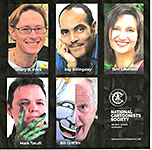
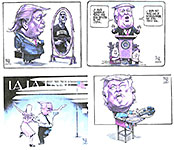
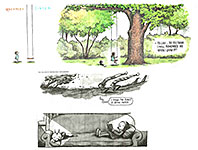

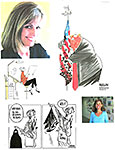
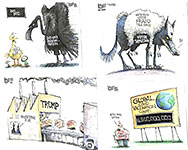
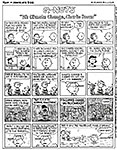
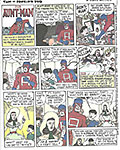

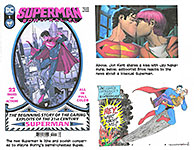
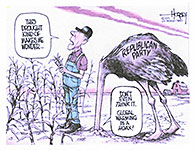
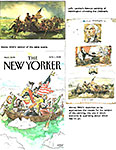
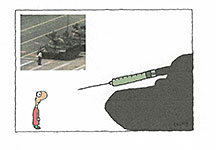
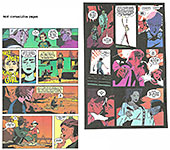
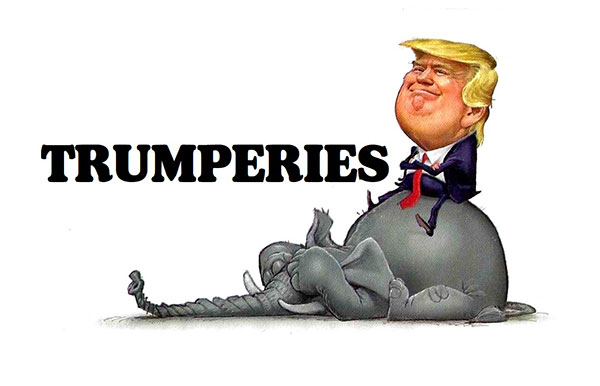
1.jpg)
1.jpg)
2.jpg)
3.jpg)
4.jpg)
5.jpg)
6.jpg)
7.jpg)
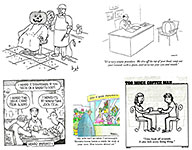

8.jpg)
9.jpg)
10.jpg)
11.jpg)
12.jpg)
13.jpg)
14.jpg)
15.jpg)
16.jpg)
17.jpg)
18.jpg)
19.jpg)
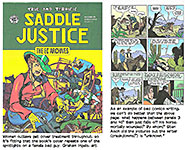
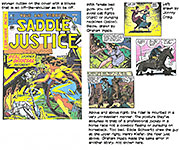
1.jpg)
2.jpg)
3.jpg)
4.jpg)
